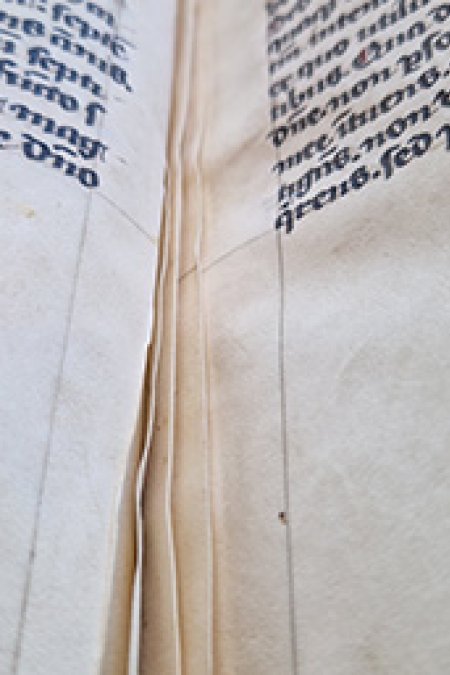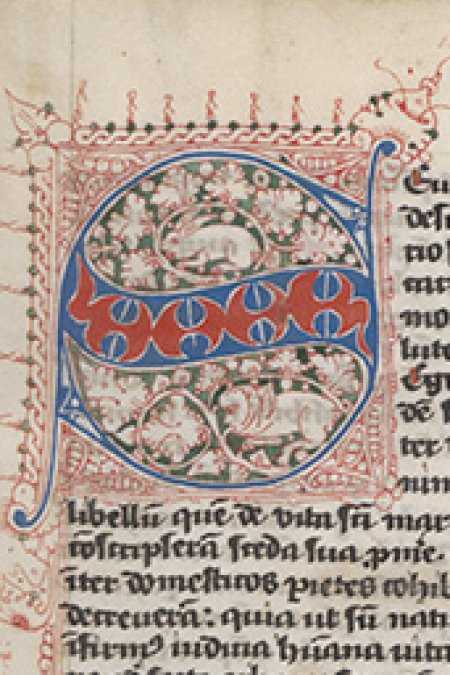Martinellus and other lives of saints (Ms. 126)
Dragons among the saints
A considerable part of the library of the Utrecht monastery of the Canon Regulars has survived. One of the 144 manuscripts and 70 printed works that have been left is Utrecht University Library, Ms. 126 that, based on the penwork, can be dated back to between 1460 and 1477 (Gerritsen-Geywitz 2017). This manuscript, counting 217 folios, contains a variety of saint’s lives, ranging from stories about St. Martin of Tours to the life of the holy Malachy, the bishop of the Irish Armagh. What more is there to tell about this rather bulky manuscript which is now in the collection of Utrecht University Library?
The monastery of the Canon Regulars

The monastery of the Canon Regulars was situated near the crowded corn market at the Oudegracht. Although it was originally founded by the zakbroeders, a mendicant order, the monastery was taken over by the Canon Regulars in 1292. As opposed to the secular canons, religious men who had a task within a collegiate church or cathedral, but lived ‘in the world’, the regular canons formed a monastic community which adhered to strict rules of ascesis and isolation from the world that were based on the rules of Church Father Augustine. As a result, works by Augustine are well-represented in the Canon Regulars’ collection that has survived (Gerritsen-Geywitz 1984).
Hard times
The years of the Utrecht Schism, a period during which there was considerable strife about who was the legitimate prince-bishop of Utrecht turned the monastic life of the Regulars upside down. The canons were forced to leave the monastery in 1427. A number of them returned five years later. In the meantime the monastery had been plundered. In 1439 the monastery was again struck by disaster when all inhabitants but two died of the plague. However, a period of recovery followed. The number of canons could eventually be filled up to fourteen, the economic situation improved and some decades of prosperity and growth started. In 1581 the monastic library was confiscated by the protestant city council and eventually moved to the new city library in the Janskerk, the predecessor of the current university library (Gerritsen-Geywitz 1984).

The monastic library

These events also left their traces in the monastic library. When the Canon Regular returned in 1432 almost nothing was left of their previous book collection. A part of the books was bought back, but the need for new books must have been enormous. Of course, the canons got to work themselves and Ms. 126 is one of the results of their labour. Just like most other books, this manuscript contains the mark of ownership of the Utrecht Canon Regulars.
Besides this mark of ownership the binding also shows that it originated from the Canon Regulars' Monastery. We know this because almost all books from this library are bound in their 15th or 16th-century binding. Although the pattern of the binding is missing at the front, the back of Ms. 126 has a clear but simple lozenge-shaped pattern.
The contents

The manuscript is written on good-quality parchment in a well readable Gothic hybrida. It looks like the entire manuscript is written by the same hand. Only the flyleaf is clearly different from the rest of the book, because it comes from a manuscript that was never finished and is therefore reused. The text on the flyleaf comes from one of the sermons by Augustine about a text in the Gospel of Matthew (Sermo 72). The actual manuscript begins, after a table of contents, with the Vita Martini. Next other texts follow, dealing with Saint Martinus, or St. Martin, the patron saint of Utrecht. Together these texts match the contents of a martinellus, a collection of stories about Saint Martinus of Tours. In Utrecht several manuscripts with stories about Saint Martinus have been handed down (Muller 2022). The texts in Ms. 126 are of the most recent date. Next follow the lives and deeds of John Chaplain, Fulgentius van Ruspe, pope Gregory the Second, Robert van Molesme, Malachias of Armagh and Francis of Assisi. The life and deeds of Francis and his followers take up the most space.
Division in quires

At the bottom of many folios the numbering of the quires is visible. That is how we find out that the quires are numbered in three parts. The first part runs from a-i, the second part from 1 – 9 and the third part again from a-i, and a half quire j. Each of the four quires contains four bifolios, except the last one which consists of two bifolios. The design is well considered, each part has the same size and a new numbering starts with a new text. For instance, the second part starts with the life of Malachias and the third part begins with the deeds of the followers of Francis. In the first part four folios have been cut out, namely the last two folios of quire ‘e’ and the first two folios of quire ‘f’. When and why this has happened is not clear. As a result, a part is missing (approximately 150 words) from the prologue preceding the text of Leontius about John Chaplain (PL 73, 339-340). The preceding Vita Bricii only misses the last sentence. The text that was in between and has been lost is probably De transitu S. Martini. This text can be found in all Dutch martinelli, except Ms. 126 (Muller 2022, 11-12), and as to size it would have fitted here. Why this text exactly would have been removed from the manuscript is not clear, the knife cuts are still visible on fol. 39.
Utrecht penwerk decorations

Although Ms. 126 is clearly decorated with penwork, it has not been included in Koert van der Horst’s catalogue of decorated manuscripts in the University Library (Van der Horst 1989). The name penwork already says it all, we are not dealing with painted decorations, but with patterns of lines applied by pen in and around the initials of a text or text parts (Gerritsen-Geywitz 2009). The use of various patterns enables us to discover relations between initials and, based on penwork decorations, it is often possible to determine where the manuscript was made (Gerritsen-Geywitz 2009 en 2017). The Utrecht dragon plays an important role in this. The dragon as it is drawn in Ms. 126 and many other books in the eye of the initial frequently occurs, especially from the late 14th century to around 1500 in Utrecht manuscripts, but not beyond (Gerritsen-Geywitz 2009). The shape of the dragon varies.
The ‘crown and dragon’ style.

The penwork decorations in Ms. 126 belong to the so-called ‘crown-and-dragon’ style. This group contains the largest number of known manuscripts by far, of which the oldest is from 1460 and the youngest from 1477. Many of the books that were written in the Canon Regular's Monastery in the years 1460 belong to this style. On folio 2r we do not see dragons, but a rabbit and an old woman with the body of an animal in the eye of the initial, and the crown motif in the right top hand corner (Gerritsen-Geywitz 2007). An initial with the same design also occurs in the Harvard Gutenberg bible. This bible was the first great work that was printed with the press designed by Gutenberg. By the penwork decorations present in the Harvard Gutenberg-bible we may deduce that that particular book was decorated in Utrecht (Gerritsen-Geywitz 2000). Not all initials decorated with penwork have dragons. On folio 93r the eye of the initial is decorated with leaves and tendrils. Yet it is clear by the crown motif at the top of the initial that it belongs to the same style. Throughout the entire manuscript the penwork decorations give colour to the text and turn an otherwise rather monotonous outlook into a lively work. It reflects the new elan of the Canon Regulars' monastery and its canons after all their setbacks, and shows that they were again part of the Utrecht religious life.
Author
Hanna Muller, April 2022; edited by Bart Jaski, May 2023.
Would you like to know more about what Special Collections can do for your research and teaching? Have a look at our page about Advice and Support.

